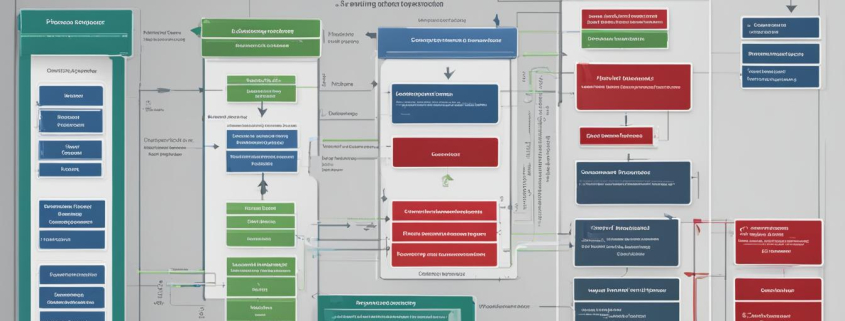Understanding What is Software Deployment – A Comprehensive Guide
Software deployment is a crucial part of the development process, ensuring that completed software is delivered and installed properly. It involves delivering and installing software updates and applications to devices, preparing the software for installation, and configuring it to meet the needs of users. The software deployment process can be manual or automated, and it plays a significant role in meeting changing business needs, enhancing productivity, and ensuring the security and compatibility of software.
In this comprehensive guide, we will explore the importance of software deployment, the different types of deployment processes, the stages involved in the deployment process, and the best practices to follow for effective software deployment. We will also discuss the challenges organizations may face during software deployment and highlight the expert assistance available to streamline the process.
Key Takeaways:
- Software deployment is crucial for delivering and installing software updates and applications properly.
- The process can be manual or automated and plays a significant role in meeting changing business needs and enhancing productivity.
- There are different types of software deployment processes, including basic deployment, rolling deployment, blue-green deployment, and canary deployment.
- The deployment process involves preparation, testing, and deployment stages, and it is important to follow best practices and utilize appropriate tools.
- Challenges in software deployment include ensuring compatibility, managing dependencies, and coordinating deployment in a multi-service environment.
Importance of Software Deployment
Software deployment is a crucial aspect of the development process, with numerous benefits and advantages for organizations. By understanding the importance of software deployment, businesses can ensure the successful installation and configuration of software, driving productivity and meeting changing business needs.
One of the key benefits of software deployment is the ability to deliver software updates and patches to users. This allows organizations to address any bugs or issues, ensuring that the software meets the desired objectives and delivers the intended benefits. Effective software deployment also enhances productivity by streamlining business operations and saving time, as users have access to the latest software versions and improvements.
In addition, software deployment plays a significant role in ensuring the security and compatibility of software. With proper deployment, organizations can implement security measures and configurations to protect against potential vulnerabilities. It also allows for compatibility testing, ensuring that the software works seamlessly with different operating systems, devices, and environments.
Overall, software deployment is essential for maximizing the potential of software solutions and driving customer satisfaction. By enabling organizations to deliver updates, enhance productivity, and ensure security and compatibility, software deployment plays a critical role in the success of software development projects.
Table: Benefits of Software Deployment
| Benefits | Advantages |
|---|---|
| Deliver software updates and patches | Address bugs and improve functionality |
| Enhance productivity | Streamline business operations and save time |
| Ensure security | Implement measures to protect against vulnerabilities |
| Ensure compatibility | Test software in different environments for seamless performance |
Types of Software Deployment
When it comes to software deployment, there are different types of processes that organizations can utilize based on their specific needs and requirements. Each type of deployment has its own advantages and considerations, allowing for flexibility and customization. Understanding the different types of software deployment can help organizations make informed decisions and choose the most suitable approach for their projects.
Basic Deployment
Basic deployment is a straightforward approach where updates or new versions of software are applied simultaneously to all target environments. This type of deployment allows for quick and efficient updates across the entire system. It is commonly used when the software update does not require extensive testing or when the risk of compatibility issues is low. Basic deployment is ideal for organizations that prioritize speed and need to ensure all users have access to the latest version of the software.
Rolling Deployment
Rolling deployment is a gradual process where the new version of software is deployed incrementally, replacing the old version in a controlled manner. This approach minimizes the risk of system downtime or disruption by updating one or a few components at a time. Rolling deployment is suitable for larger systems with multiple components or when the organization wants to minimize the impact of potential issues. It allows for thorough testing and verification of the new version before it is fully rolled out.
Blue-Green Deployment
Blue-green deployment involves running two parallel versions of the software, referred to as “blue” and “green.” The live traffic is directed to one version while the other version is updated or patched. This approach allows for seamless switching between the versions in case of issues or the need to roll back. Blue-green deployment is useful for organizations that require high availability and want to minimize the risk of downtime during updates. It offers a smooth transition from the old version to the new one while ensuring continuous service for users.
Canary Deployment
Canary deployment involves deploying updates incrementally to a small group of users, also known as the “canary group.” This allows organizations to test the new version with a limited user base before fully deploying it to all users. Canary deployment helps identify any potential issues or bugs and allows for quick adjustments or rollbacks if necessary. It is especially useful for organizations that prioritize stability and want to ensure a smooth user experience during updates.
Understanding the different types of software deployment provides organizations with the flexibility and knowledge to choose the most suitable approach for their specific needs. Whether it’s a basic deployment, rolling deployment, blue-green deployment, or canary deployment, each type offers unique benefits and considerations. By selecting the right deployment strategy, organizations can ensure smooth and successful software updates while minimizing downtime and disruptions.
You are currently viewing a placeholder content from YouTube. To access the actual content, click the button below. Please note that doing so will share data with third-party providers.
The Software Deployment Process
The software deployment process involves several stages that ensure successful installation and configuration of software. These stages include preparation, testing, and deployment. Each stage plays a crucial role in ensuring that the software is ready for use and performs optimally.
Preparation Stage
In the preparation stage, developers gather all the necessary resources and files required for the deployment. This includes the code, configuration files, and any dependencies. It is important to ensure that all the components are intact and properly organized to facilitate a smooth deployment process.
Testing Stage
Once the preparation stage is complete, the software is deployed to a test environment for thorough testing. This stage allows developers to identify and fix any bugs, errors, or compatibility issues. It is essential to conduct comprehensive testing to ensure that the software meets the desired specifications and performs as expected.
Deployment Stage
The final stage of the software deployment process is the actual deployment to the live environment. During this stage, the software is installed and configured on the target devices. It is important to monitor the performance of the software after deployment to ensure that it is functioning correctly. Any issues or glitches that arise during this stage should be addressed promptly to ensure a successful deployment.
By following these stages of the software deployment process, organizations can ensure a smooth and efficient deployment of their software solutions. It is crucial to have a well-defined checklist and adhere to best practices throughout each stage to minimize errors and maximize the benefits of the deployed software.
| Stage | Description |
|---|---|
| Preparation | Gathering all necessary resources and files for deployment. |
| Testing | Thoroughly testing the software in a test environment to identify and fix any bugs or compatibility issues. |
| Deployment | Installing and configuring the software on the live environment and monitoring its performance. |
Software Deployment Methods
When it comes to software deployment, there are two main methods that organizations can utilize: network-based deployment and agent-based deployment. Each method has its own unique characteristics and considerations, allowing organizations to choose the approach that best suits their specific requirements and infrastructure.
Network-based deployment involves connecting IT devices to release and deploy software updates. This method relies on a centralized network or server to distribute and install the software across multiple devices simultaneously. It is commonly used in larger organizations where a centralized approach is preferred, making it efficient for deploying updates to a large number of devices.
On the other hand, agent-based deployment uses an internet connection to deploy software to individual devices. With this method, each device has an agent installed that communicates with a central server to receive and install the software updates. This approach is more suitable for organizations with a distributed infrastructure or a large number of remote devices, as it allows for more flexibility and control over the deployment process.
| Network-based Deployment | Agent-based Deployment |
|---|---|
| Centralized approach | Distributed approach |
| Efficient for large-scale deployments | Flexible for remote and distributed devices |
| Requires a stable and robust network | Relies on internet connectivity for communication |
| Updates are deployed simultaneously to all devices | Updates can be deployed individually to each device |
Both network-based deployment and agent-based deployment have their advantages and considerations. The choice between the two methods depends on factors such as the organization’s network infrastructure, the number and location of devices, and the level of control required over the deployment process. By understanding these methods, organizations can make informed decisions and implement efficient and effective software deployment practices.
Software Deployment Tools
When it comes to software deployment, having the right tools can make all the difference. Here are some of the top software deployment tools that organizations can consider:
- AWS CodeDeploy: A powerful tool offered by Amazon Web Services (AWS), CodeDeploy helps automate the deployment process for software updates to Amazon EC2 instances. It simplifies deployments and ensures consistency across environments.
- Bamboo: Bamboo is a continuous integration and deployment tool that offers a seamless and straightforward deployment process. It integrates well with other Atlassian products and supports a variety of build and deployment processes.
- Jenkins: Jenkins is an open-source automation server that provides an extensive plugin ecosystem, allowing for easy integration with various tools and platforms. It offers flexibility and scalability, making it a popular choice for automating software deployments.
- Octopus Deploy: Octopus Deploy is an automated release management tool that focuses on modern developers and DevOps teams. It provides a centralized platform for managing deployments and offers features like variable substitution and rollbacks.
- GitLab CI: Integrated into the GitLab platform, GitLab CI is a powerful continuous integration tool. It allows for automated testing and deployment, ensuring that developers can easily deliver their code to different environments.
These software deployment tools offer a range of functionalities and support various platforms and infrastructures. Organizations can choose the tool that best fits their specific needs and requirements.
Conclusion
Effective software deployment is crucial for organizations to ensure smooth and successful implementation of software updates and patches. By leveraging the right tools like AWS CodeDeploy, Bamboo, Jenkins, Octopus Deploy, and GitLab CI, organizations can automate and streamline their deployment processes, reducing the chances of errors and enhancing productivity.
These tools provide features like automation, scalability, and integration capabilities, empowering organizations to deliver high-quality software to their end-users. Whether it’s managing deployments on cloud-based infrastructures or implementing continuous integration practices, these software deployment tools offer the necessary functionalities to meet the diverse needs of organizations.
With the right combination of tools and best practices, organizations can achieve efficient and effective software deployment, ensuring their software solutions are installed, configured, and ready for use.
Challenges in Software Deployment
Software deployment can be a complex process, and organizations often face various challenges that can hinder the smooth implementation and functioning of their software solutions. Understanding these challenges is crucial for devising effective strategies to overcome them. In this section, we will discuss some common challenges in software deployment and explore potential solutions.
Compatibility and Configuration Management
One of the primary challenges in software deployment is ensuring compatibility with the target system and managing configuration changes. Different devices, operating systems, and software versions may have unique requirements and dependencies that need to be addressed during deployment. Failure to handle these compatibility issues can lead to software errors, crashes, and performance issues.
Effective configuration management practices, such as version control systems, can help organizations track and manage configuration changes, ensuring that the deployed software is compatible with the target environment. Regular testing and quality assurance processes can also detect and resolve compatibility issues before deployment.
Reliability and Repeatability
Another challenge in software deployment is ensuring the reliability and repeatability of the deployment process. Organizations need to ensure that the software is deployed consistently and accurately across different environments and that the deployment process can be repeated without errors.
Automation plays a crucial role in achieving reliable and repeatable deployments. By automating deployment processes, organizations can eliminate manual errors and ensure consistent deployment across environments. Implementing continuous integration and continuous deployment (CI/CD) pipelines can further enhance reliability and repeatability by automating build, test, and deployment processes.
Coordinating Deployment in a Multi-Service Environment
In a complex environment with multiple interconnected services, coordinating software deployment can be challenging. Changes made to one service can impact other dependent services, making it critical to synchronize deployment activities and minimize disruptions.
Effective coordination and communication among different teams are key to successful software deployment in a multi-service environment. Setting up clear communication channels, defining deployment schedules, and conducting thorough testing and validation can help mitigate potential conflicts and ensure a smooth deployment process.
Overcoming these challenges requires careful planning, effective communication, and the adoption of best practices in software deployment. By addressing compatibility and configuration management issues, ensuring reliability and repeatability, and coordinating deployment in multi-service environments, organizations can navigate the complexities of software deployment and achieve successful outcomes.
Software Deployment Best Practices
Effective software deployment requires following best practices to ensure smooth and successful implementation. By implementing the following strategies, organizations can minimize risks, enhance efficiency, and maximize the benefits of deploying software:
- Thoroughly test before deployment: Prior to deploying software, it is crucial to conduct comprehensive testing to identify any bugs or errors. Thorough testing helps to ensure that the software functions as intended and minimizes the risk of issues arising during deployment.
- Establish a well-defined and documented deployment process: Having a clearly defined deployment process documented and accessible to the team ensures consistency and promotes efficient execution. This documentation should include step-by-step instructions, checklists, and guidelines for each stage of deployment.
- Utilize version control systems: Using version control systems such as Git enables organizations to track changes, manage different software versions, and roll back to previous versions if necessary. Version control systems provide a reliable and organized approach to software deployment.
- Automate deployment processes: Automation plays a crucial role in software deployment as it reduces the chance of human error and speeds up the deployment process. Deployment tools like Jenkins, Octopus Deploy, and GitLab CI provide automation capabilities, allowing organizations to streamline deployment and ensure consistency.
- Monitor software after deployment: Monitoring the performance of software after deployment is essential to catch any issues that may arise. Implementing monitoring tools and conducting regular checks helps identify any performance bottlenecks, security vulnerabilities, or compatibility issues that may require attention.
By adhering to these best practices, organizations can significantly improve the efficiency and success rate of their software deployments.
Implementing best practices for deploying software is essential for organizations to ensure successful and efficient deployment processes. Thorough testing, a well-defined deployment process, version control systems, automation, and post-deployment monitoring are all critical components of effective software deployment.
Thorough testing before deployment helps identify and fix any issues, reducing the chance of problems arising during deployment. Establishing a well-defined and documented deployment process promotes consistency and efficiency, allowing the team to follow a standardized approach. Utilizing version control systems ensures organized management of software versions and the ability to roll back if necessary.
Automation streamlines the deployment process, reducing the risk of human error and speeding up deployment times. Monitoring software performance after deployment helps identify any issues and allows for timely resolution. By following these best practices, organizations can achieve successful software deployments and maximize the benefits of their software solutions.
Expert Software Deployment Assistance
When it comes to software deployment, having expert assistance can significantly streamline the process and ensure that industry best practices are followed. At Zibtek, we offer top-notch software deployment services to help organizations create a customized deployment process tailored to their unique needs. With our expertise and experience, we can guide you in selecting and utilizing the best deployment tools for optimal results.
Our software deployment consultancy services aim to support you throughout the entire deployment journey. We can assist in preparing the software for installation, ensuring compatibility with the target system, and managing configuration changes effectively. Our team of professionals will work closely with you to understand your specific requirements and develop a deployment strategy that addresses any challenges you may encounter.
Whether you need assistance with network-based deployment or agent-based deployment, our experts have the knowledge and skills to ensure a successful deployment. We can help you navigate through potential pitfalls and provide practical solutions to meet your objectives. With our software deployment services, you can save time, reduce risks, and achieve efficient and effective software deployment.
Why Choose Zibtek for Software Deployment?
- Expertise: Our team consists of experienced professionals who are well-versed in software deployment best practices.
- Customization: We understand that every organization has unique deployment requirements, and we tailor our services to meet your specific needs.
- Efficiency: By leveraging our expertise and utilizing the right tools, we can ensure a smooth and efficient deployment process.
- Support: We provide ongoing support and guidance throughout the deployment process, ensuring that you have the assistance you need every step of the way.
So, if you’re looking for expert software deployment assistance, trust Zibtek to deliver outstanding results. Contact us today to learn more about how we can help you achieve successful software deployment and maximize the benefits of your software solutions.
Conclusion
In conclusion, software deployment is a crucial process in the development lifecycle that ensures the successful installation and configuration of software solutions. By following best practices and utilizing the right tools, organizations can achieve efficient and effective software deployment.
Software deployment plays a significant role in meeting changing business needs, enhancing productivity, and delivering software updates and patches to users. It allows developers to drive customer satisfaction by fulfilling their intended purpose and delivering desired benefits.
By involving stakeholders, communicating effectively, and having a rollback plan in place, organizations can mitigate challenges and ensure a smooth deployment process. Additionally, seeking expert assistance from companies like Zibtek can help streamline the process and ensure the application of industry best practices.
In summary, software deployment is a critical aspect of software development that requires careful planning, testing, and execution. By prioritizing effective deployment strategies, organizations can maximize the benefits of their software solutions and meet the needs of their users.
FAQ
What is software deployment?
Software deployment is the process of delivering and installing software updates and applications to devices, preparing the software for installation, and configuring it to meet the needs of users.
Why is software deployment important?
Software deployment is important because it enables developers to deliver software updates and patches to users, meet changing business needs, enhance productivity, and ensure the security and compatibility of software.
What are the different types of software deployment?
The different types of software deployment include basic deployment, rolling deployment, blue-green deployment, and canary deployment.
What are the stages of the software deployment process?
The stages of the software deployment process include preparation, testing, and deployment.
What are the methods of software deployment?
The methods of software deployment include network-based deployment and agent-based deployment.
What are some popular software deployment tools?
Popular software deployment tools include AWS CodeDeploy, Bamboo, Jenkins, Octopus Deploy, and GitLab CI.
What challenges can arise during software deployment?
Challenges in software deployment can include ensuring compatibility, managing dependencies and conflicts, handling configuration changes, and coordinating deployment in a multi-service environment.
What are some best practices for effective software deployment?
Best practices for effective software deployment include thorough testing before deployment, establishing a well-defined and documented deployment process, using version control systems, automating deployment processes, and monitoring the software after deployment.
How can expert assistance in software deployment be beneficial?
Expert assistance in software deployment can help organizations streamline the process, follow industry best practices, select the right tools, and achieve efficient and effective software deployment that meets their objectives.
Source Links
- https://www.zibtek.com/blog/everything-you-need-to-know-about-software-deployment/
- https://learn.g2.com/software-deployment
- https://www.ninjaone.com/blog/software-deployment-process/
- About the Author
- Latest Posts
Mark is a senior IT technician at Biteno.com . He writes about Linux, Windows and Software.









